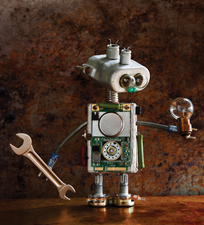An ASCII puzzle for an escape room challenge
Jail Break

© Lead Image © besjunior; 123rf.com
A digital puzzle presents a challenge for young people in an escape room.
A teacher recently asked me to help create a couple of puzzles for an escape room she was designing for her classes. Escape rooms have a number of interpretations, themes, and implementations but ultimately comprise a series of puzzles designed around a theme. Solving one puzzle provides a clue to something else. Sometimes a puzzle is just an off-the-shelf combination lock, and as you play other parts of the game, you'll discover the combination (or three numbers that you can try as the combination).
One puzzle I designed starts with a number on a seven-segment display (see the "Seven-Segment Display" box), a bundle of leads clipped onto two rows of electrical connections, and an unfinished set of notes. A previous adventurer has started to decode the puzzle and left notes for whoever might follow. The top set of connections is numbered 128, 64, 32, 16 , 8, 4, 2, and 1. The bottom set of connections isn't labeled, but each post has an associated LED, only a few of which are lit.
Theory of Operation
Built into the code of the display box, the secret word to be revealed is part of an Arduino program. The number displayed is the ASCII representation of the character currently being sought. Players must use clip leads to connect the numbers on the top to the active (lit) connections on the bottom so that the connected posts add up to the displayed number. A "check" post is tapped with an extra clip lead, and the display will either say CORRECT or NO.
[...]
Buy this article as PDF
(incl. VAT)
Buy Linux Magazine
Subscribe to our Linux Newsletters
Find Linux and Open Source Jobs
Subscribe to our ADMIN Newsletters
Support Our Work
Linux Magazine content is made possible with support from readers like you. Please consider contributing when you’ve found an article to be beneficial.

News
-
Photoshop on Linux?
A developer has patched Wine so that it'll run specific versions of Photoshop that depend on Adobe Creative Cloud.
-
Linux Mint 22.3 Now Available with New Tools
Linux Mint 22.3 has been released with a pair of new tools for system admins and some pretty cool new features.
-
New Linux Malware Targets Cloud-Based Linux Installations
VoidLink, a new Linux malware, should be of real concern because of its stealth and customization.
-
Say Goodbye to Middle-Mouse Paste
Both Gnome and Firefox have proposed getting rid of a long-time favorite Linux feature.
-
Manjaro 26.0 Primary Desktop Environments Default to Wayland
If you want to stick with X.Org, you'll be limited to the desktop environments you can choose.
-
Mozilla Plans to AI-ify Firefox
With a new CEO in control, Mozilla is doubling down on a strategy of trust, all the while leaning into AI.
-
Gnome Says No to AI-Generated Extensions
If you're a developer wanting to create a new Gnome extension, you'd best set aside that AI code generator, because the extension team will have none of that.
-
Parrot OS Switches to KDE Plasma Desktop
Yet another distro is making the move to the KDE Plasma desktop.
-
TUXEDO Announces Gemini 17
TUXEDO Computers has released the fourth generation of its Gemini laptop with plenty of updates.
-
Two New Distros Adopt Enlightenment
MX Moksha and AV Linux 25 join ranks with Bodhi Linux and embrace the Enlightenment desktop.

